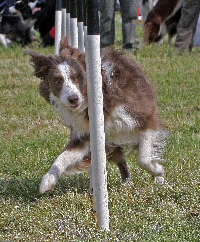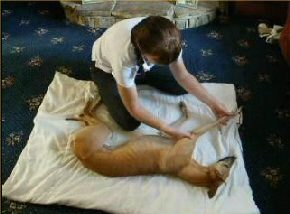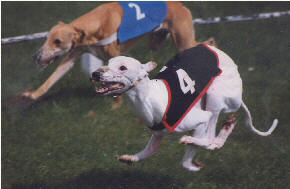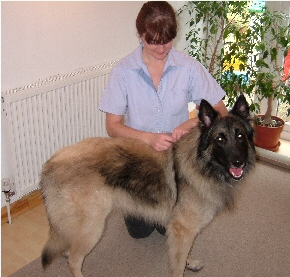More about McTimoney
|
|
|
|
Is your dog fit for purpose?
|
|
So just as top human athletes depend on regular massage and treatment, so do our competition dogs, ourselves as handlers and even our non-competing family members. 'Agility dogs are brought for chiropractic treatment some when they are uncomfortable or showing signs of pain, or when performance is affected - perhaps the dog is 'measuring', taking the turns more slowly or missing a weave pole due to lack of flexibility,' Susan says.
This can cause an imbalance in the muscles of the body and often lead to neck and shoulder problems as well as back and pelvic issues as the dog continually compensates for the imbalance. 'Agilty dogs also get problems around the withers and shoulders from the jarring on contacts and the impact from tight turns it's essential that handlers learn to train their dogs to land and turn gently,' Susan warns. |
Chiropractic is a method of adjusting the bones of the body to improve the alignment of the skeleton and allow the nervous system to function more efficiently. Chiropractors train to treat people and must be registered with the General Chiropractic Council. As well as being a Chiropractor, Susan also has a further two-year post-graduate diploma in animal manipulation and qualifications in Equine, Canine and Human massage. Susan now uses these techniques on animals as well as humans. In all instances when treating animals, veterinary permission must be sought and granted before a chiropractor is allowed in law to treat an animal presented to them. |
A dog that is exhaling sharply - almost barking on landing into a tight turn, is often the product of insufficient 'shaping' by the handler.
 'If you slow motion a film of a dog weaving you really
see how many muscles and how much movement is actually involved whether they bounce' or
swim' the weaves and how much demand is placed on their bodies' a good reason to get a
friend to video your dog's performance in the ring.'
'If you slow motion a film of a dog weaving you really
see how many muscles and how much movement is actually involved whether they bounce' or
swim' the weaves and how much demand is placed on their bodies' a good reason to get a
friend to video your dog's performance in the ring.'
Flyball, often enjoyed by agility dogs, is also incredible to watch dogs look as if they simply grab the ball and run. 'But the impact on the ball-release and the repetitive action as they brake and turn usually in one direction can build up muscle strain,' Susan tells me. 'The dogs really drop one shoulder in this turn and this in time can lead to asymmetry and potentially longer term injury. Again, they need occasional checks - chiropractic can help them to be less asymmetrical and keep them flexible in between flyball exertions!'
What about the rescue dog?
 'I would check any dog that has been rehomed, because
you don't know the previous history,' Susan says. 'If they've been tied, up, crated and not
allowed out, or mistreated, they may have suffered some form of musculo-skeletal injury.
Aggression is often a symptom of pain.
'I would check any dog that has been rehomed, because
you don't know the previous history,' Susan says. 'If they've been tied, up, crated and not
allowed out, or mistreated, they may have suffered some form of musculo-skeletal injury.
Aggression is often a symptom of pain.
I will never forget a tiny Yorkie, one of the scariest dogs I've ever met, who was in so much pain he tried to bite whenever he was touched. He hated other dogs and was quite temperamental with people too all because he was sore in his back and hind leg. After a course of treatment, he is a completely different dog, very bright, pleased to see you and loving. Now he runs into the clinic for his treatment and interim checks!'
People often assume there will be nothing wrong with a puppy, but Susan explains that sometimes they, too, can have a slight imbalance even as the result of the birthing process.
'A simple early check can give you the blueprint of the individual, so if they do return having had an accident later in life, you have something with which to compare them,' she explains. 'Puppies play, fall and tumble and you want them to develop straight and as healthy and symmetrical as possible. The treatment for a puppy is very gentle and it also gets them used to being handled by other people.'
'Very often a young dog's pelvis might be slightly crooked, leading to tension in the bottom and spine left it may get worse and in addition cause further compensatory changes in other areas of the body. If you treat at an early age, it usually saves numerous treatments later. Often people think a dog has nothing wrong and only come for treatment when the dog is lame or won't jump. Unfortunately by then the damage is done and is established often leaving a long-term weakness. It is much better to use Chiropractic as a preventive measure and alleviate problems before they become established and cause long-term issues.'
 Different
breeds of dog may suffer different types of injury because of their conformation, breed
weaknesses, or the job they do. Susan treats a number of racing Whippets, for instance, who
often present with a history of deterioration in their performance or non-specific injuries
leaving them hunched up and uncomfortable.
Different
breeds of dog may suffer different types of injury because of their conformation, breed
weaknesses, or the job they do. Susan treats a number of racing Whippets, for instance, who
often present with a history of deterioration in their performance or non-specific injuries
leaving them hunched up and uncomfortable.
'It is not unusual for them to somersault, slide across the ground and pile into each other in pursuit of the lure at the end of a race,' Susan says. 'Dogs can also bump or hit one another, often causing injury. Whippets and greyhounds also often race on a curve and always in one direction: this can lead to asymmetry in the pelvis and associated muscles causing shortened stride length or restriction that can knock valuable seconds off their time. Chiropractic care can increase a dog's range of movement creating a longer stride therefore increasing speed.'
 Working Huskies also come to the clinic and they often have tight pectoral muscles from
throwing themselves into the harness and, of course, Canicross again popular with agility
handlers - also demands the same pulling technique.
Working Huskies also come to the clinic and they often have tight pectoral muscles from
throwing themselves into the harness and, of course, Canicross again popular with agility
handlers - also demands the same pulling technique.
'German Shepherds often present with hip or hind leg issues, Labradors too often have hip and elbow problems, sometimes aggravated by being allowed to become obese,' Susan explains. 'Other breeds have very real problems and we can only help alleviate some of the symptoms rather than cure the problem for example Cavalier King Charles Spaniels often sadly diagnosed with Syringomyelia and present with pain and sensitivity in the back.' Susan stresses that when treating these dogs it is always with full veterinary referral and history.
'Dachshunds are a good example, because their long back, short legs and a metabolic difference in the make-up of their discs that render them prone to Intervertebral Disc Disease,' she adds. 'Approximately one in four will have some degree of disc related problem in their life. Many present with symptoms of pain sometimes accompanied with some sort of weakness or paralysis of one or in extreme cases all four limbs.
'The worst case I saw was a quadriplegic dog referred from the vet, which could barely even move her head,' she remembers. 'Two very gentle treatments produced a feeble wag of the tail and slight movement of the head. Gradually with time and treatment even she became able to walk again.'
Pet dogs often get non-specific lameness or discomfort. They may want to stay in bed or not want to go for a walk or get into the car.
 'Often this can be the result of some form of
unrecognised accident or repetitive injury - even chasing a tennis ball several times a day
can cause a repetitive injury from leaping onto the air, twisting and jarring on landing,'
Susan says. 'The chukkie toy is great fun but can cause issues. The dog goes repetitively
from standstill to flat out, comes to a sliding halt or jumps and twists to get the ball and
is then sent out again often multiple l times and on a daily basis!'
'Often this can be the result of some form of
unrecognised accident or repetitive injury - even chasing a tennis ball several times a day
can cause a repetitive injury from leaping onto the air, twisting and jarring on landing,'
Susan says. 'The chukkie toy is great fun but can cause issues. The dog goes repetitively
from standstill to flat out, comes to a sliding halt or jumps and twists to get the ball and
is then sent out again often multiple l times and on a daily basis!'
She warns: 'Playing chukkie is fun to do in moderation, but be aware of what your dog is doing and the impact it has on his body. The best way to see this is to video him and play it back in slow motion.'
'Dogs have to have fun but if owners are made aware of what causes problems they can modify their dog's routine so he remains safe and injury free,' Susan says.
Whether the dog is competing or just playing ball in the park, Susan stresses that it is really important to warm them up first. Before a competition they should go for a walk run and turn and if possible to do a couple of jumps.
'I find it fascinating that you wouldn't take a horse into the competition ring without doing practice jumps first but at agility competitions there are no practice jumps just a long, sometimes cold queue,' she says. 'It is also just as important to cool down' after a round you need to walk the dog not just run it back to the car or van and return it to its crate!' A cool down period allows a gradual decline in heart rate thereby reducing stress on the organ and reduces the lactic acid which builds up in the muscles, Susan explains that when a dog has an underlying pathological problem such as arthritis of the hip or elbow they will compensate, and of course they have four legs to compensate with!
'At the beginning the compensatory changes can be so subtle they go un-noticed especially as the hip or elbow problem is of primary concern and more obvious. Over time, however, the compensation can affect other areas of the body leading to more complex problems later on. While chiropractic can't cure the actual arthritis it can prevent the secondary problems progressing into other areas of the body which often make the animal seem much worse than it really is.'
About
the author...
Susan Sargeant is a McTimoney Chiropractor the form of chiropractic developed by the
late John McTimoney that has evolved into a whole-body treatment and aims to find the cause of
the problem not just the symptoms.
Susan's main focus is now about one-third human, one-third dog and one third horses and other animals. She also treats the occasional cat or rabbit!'
You can find your nearest McTimoney Chiropractor on www.mctimoneychiropractic.org or by telephoning them on tel. 01491 829211.
Thank you to Lee Windeatt and Lisa Jordan for permission to use images of their dogs.
First published 23 April 2010
|
[bottom.htm] © Copyright Agilitynet |